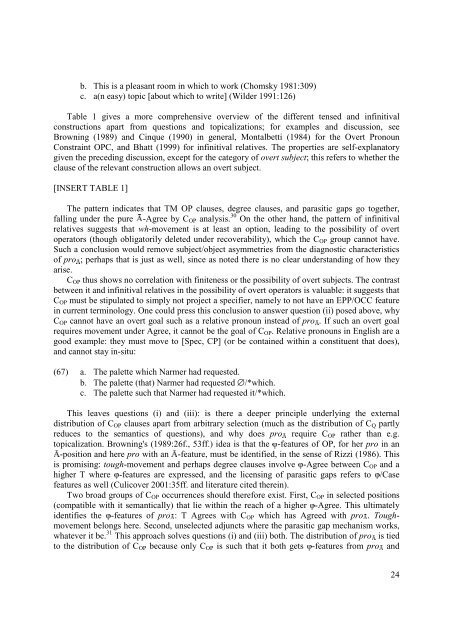1 On tough-movement* Milan Rezac, University ... - Multimania.co.uk
1 On tough-movement* Milan Rezac, University ... - Multimania.co.uk
1 On tough-movement* Milan Rezac, University ... - Multimania.co.uk
Create successful ePaper yourself
Turn your PDF publications into a flip-book with our unique Google optimized e-Paper software.
. This is a pleasant room in which to work (Chomsky 1981:309)<br />
c. a(n easy) topic [about which to write] (Wilder 1991:126)<br />
Table 1 gives a more <strong>co</strong>mprehensive overview of the different tensed and infinitival<br />
<strong>co</strong>nstructions apart from questions and topicalizations; for examples and discussion, see<br />
Browning (1989) and Cinque (1990) in general, Montalbetti (1984) for the Overt Pronoun<br />
Constraint OPC, and Bhatt (1999) for infinitival relatives. The properties are self-explanatory<br />
given the preceding discussion, except for the category of overt subject; this refers to whether the<br />
clause of the relevant <strong>co</strong>nstruction allows an overt subject.<br />
[INSERT TABLE 1]<br />
The pattern indicates that TM OP clauses, degree clauses, and parasitic gaps go together,<br />
falling under the pure Ā-Agree by C OP analysis. 30 <strong>On</strong> the other hand, the pattern of infinitival<br />
relatives suggests that wh-movement is at least an option, leading to the possibility of overt<br />
operators (though obligatorily deleted under re<strong>co</strong>verability), which the C OP group cannot have.<br />
Such a <strong>co</strong>nclusion would remove subject/object asymmetries from the diagnostic characteristics<br />
of pro Ā ; perhaps that is just as well, since as noted there is no clear understanding of how they<br />
arise.<br />
C OP thus shows no <strong>co</strong>rrelation with finiteness or the possibility of overt subjects. The <strong>co</strong>ntrast<br />
between it and infinitival relatives in the possibility of overt operators is valuable: it suggests that<br />
C OP must be stipulated to simply not project a specifier, namely to not have an EPP/OCC feature<br />
in current terminology. <strong>On</strong>e <strong>co</strong>uld press this <strong>co</strong>nclusion to answer question (ii) posed above, why<br />
C OP cannot have an overt goal such as a relative pronoun instead of pro Ā . If such an overt goal<br />
requires movement under Agree, it cannot be the goal of C OP . Relative pronouns in English are a<br />
good example: they must move to [Spec, CP] (or be <strong>co</strong>ntained within a <strong>co</strong>nstituent that does),<br />
and cannot stay in-situ:<br />
(67) a. The palette which Narmer had requested.<br />
b. The palette (that) Narmer had requested ∅/*which.<br />
c. The palette such that Narmer had requested it/*which.<br />
This leaves questions (i) and (iii): is there a deeper principle underlying the external<br />
distribution of C OP clauses apart from arbitrary selection (much as the distribution of C Q partly<br />
reduces to the semantics of questions), and why does pro Ā require C OP rather than e.g.<br />
topicalization. Browning's (1989:26f., 53ff.) idea is that the φ-features of OP, for her pro in an<br />
Ā-position and here pro with an Ā-feature, must be identified, in the sense of Rizzi (1986). This<br />
is promising: <strong>tough</strong>-movement and perhaps degree clauses involve φ-Agree between C OP and a<br />
higher T where φ-features are expressed, and the licensing of parasitic gaps refers to φ/Case<br />
features as well (Culi<strong>co</strong>ver 2001:35ff. and literature cited therein).<br />
Two broad groups of C OP occurrences should therefore exist. First, C OP in selected positions<br />
(<strong>co</strong>mpatible with it semantically) that lie within the reach of a higher φ-Agree. This ultimately<br />
identifies the φ-features of pro Ā : T Agrees with C OP which has Agreed with pro Ā . Toughmovement<br />
belongs here. Se<strong>co</strong>nd, unselected adjuncts where the parasitic gap mechanism works,<br />
whatever it be. 31 This approach solves questions (i) and (iii) both. The distribution of pro Ā is tied<br />
to the distribution of C OP because only C OP is such that it both gets φ-features from pro Ā and<br />
24
















